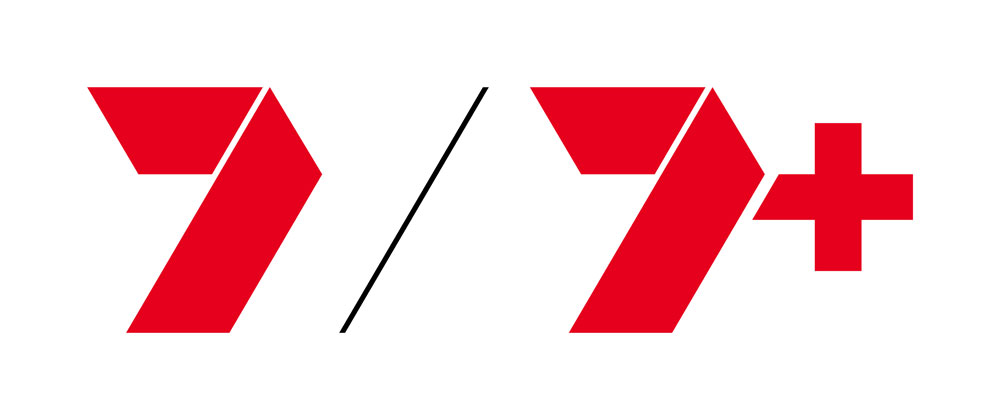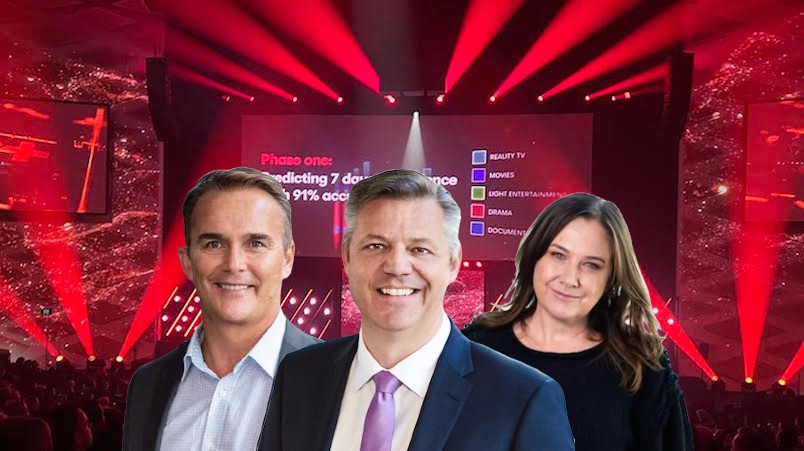Seven guns for global streamers with AWS personalisation – 7plus viewing up 48%; next is ad loads tailored to viewer tolerance; industry froths at cricket, AFL play
An Mi3 editorial series brought to you by
7 / 7plus


Harnessing SxSW trade winds: Kurt Burnette, James Warburton and Mel Hopkins.
With a few disgruntled exceptions, most advertisers and media buyers exited Sydney’s International Convention Centre last night after Seven’s “massive” Upfronts pitch, relieved that it fell well short of a two-hour epic and cautiously upbeat about an AI-laden rollout of initiatives and all-screen sporting rights that Chief Revenue Officer Kurt Burnette declared was the “biggest news of any upfronts” and the “biggest change-up to sports rights in history”. The snappy event was the first for former Optus CMO Mel Hopkins, who as the show’s Executive Producer and Seven’s new-ish Chief Marketing & Audience Officer, beseeched a few thousand to keep an open mind as she channeled her past life in the audience as a customer of Seven “intrigued … and perhaps a little skeptical”.
What you need to know
- Most media buyers upbeat after Seven upfronts, but want more details on key announcements
- Seven’s Chief Digital Officer Gereurd Roberts says embedding Amazon's personalisation engine puts the broadcaster on equal terms with global video on demand operators
- Switch to AI is driving big increases in minutes viewed and viewer interactions, says Seven. And it says a new AI platform will help it predict what the audience on 7plus would be over the next seven days with 91 per cent accuracy
- By 2030 everything will be 'personalised, optimised and addressable,' says Seven Chief Revenue Officer Kurt Burnette
We’ve moved from being one product for all where everyone’s seeing the same thing, to being truly one-to-one. We’ve got 13.5 million registered users … we now have 13.5 million different versions of Seven products because every single one is unique, tailored to the individual user and to their preferences.
Battling back
The mood was upbeat and the acknowledgements plentiful that Seven kept pace last night with its arch-rival and Olympics poacher, Nine, for its 2024 plans across free-to-air and digital screens.
A few media buyers Mi3 spoke to thought Seven’s gig was too same-same with past broadcaster upfront formats but the vast majority left with praise – qualified by their desire for more detail on a handful of key announcements.
One blue chip marketer, who spoke to Mi3 after the show on the condition of anonymity, said it was “one of the best I’ve seen … the most exciting thing to me is to have sport like the AFL and cricket not behind a paywall so it can be watched live on TV or streamed in any way on any device.”
The executive’s biggest lament was for more detail on the grassroots community sports platform, Streamer, which Seven plugged last night. “That feels like a massive opportunity to get to the sports that aren’t your big AFL or primetime cricket codes. If I want to watch local touch football, softball or netball, you have to get to those games. That’s impossible. And as an advertiser, you want to get to the people, the real people.”
Like a number of media buyers, a new show called Dream Home was called out by the advertiser as one which tapped the current economic mood by tapping “the heart”.
Addressable aggressiveness
Among the line-up of new initiatives and next year’s content, AI was heaving.
Seven’s Chief Digital Officer Gereurd Roberts delivered a spray of impressive numbers after an 18 month program embedding an AWS personalisation engine into the 7plus platform, which he said put it on par with the “very best” of global video on demand [VOD] operators and “on a different level to our competitors”.
Personalised shows, visuals and prompts for the 13.5 million registered users to 7plus had so far delivered a 48 per cent increase in minutes viewed and three times the viewer interactions over “previous human” curation, per Roberts.
“We’ve moved from being one product for all, where everyone’s seeing the same thing, to being truly one-to-one. We’ve got 13.5 million registered users … we now have 13.5 million different versions of Seven products because every single one is unique, tailored to the individual user and to their preferences.”
Seven Chief Revenue Officer Kurt Burnette said Seven’s ambition was “that by 2030, every ad and integration served by Seven West Media will be personalised, optimised and addressable. We are well and truly on that journey.”
They’re being smarter with their tech than I thought they would be. It was super interesting and exciting for our country to give the global streaming players a run for their money.
Netflix neuterer?
Those snippets were enough for Wavemaker’s Chief Content & Partnerships Officer Shivani Maharaj to reverse her view heading into the show. “They’re being smarter with their tech than I thought they would be,” she said. “It was super interesting and exciting for our country to give the global streaming players a run for their money.”
Seven also attempted some myth-busting around the scale of some of its streamed shows versus the global streaming services – Home & Away, for instance, had three times the viewers of Apple TV’s runaway hit Ted Lasso.
IAG’s Communication Planning & Media Lead, Mark Echo, acknowledged there were wayward perceptions among industry professionals. “There’s definitely a job to do,” he said. “It’s a lesson around talkability.”
Maharaj noted “it’s a shame Australia is just lured more by Hollywood.” Spark Foundry CEO Imogen Hewitt said: “I’m intrigued by the amount of viewing which is happening on 7plus, which is not connected to anything on linear.”
Personalised adloads
But just like those steak knife TV infomercials, Roberts had more on the tech and AI front.
Beyond the personalised viewing and content rollout, he said Seven had started six weeks ago on a three-phase program with cloud-based AI company Databricks. The first phase had just completed, allowing Seven to predict what the audience on 7plus would be over the next seven days with a 9 per cent margin of error, or in Robert’s words “91 per cent accuracy”.
Stage two, now underway, would see 7plus audience predictions broken down by target segments and demographics. The final leg will likely bring Christmas to viewers year round – Seven will use Databricks AI to identify advertising tolerance by audience segment and dynamically adjust adloads accordingly. The trick here though is what’s good for the viewer may not be for advertisers – shorter ad pods could mean higher ad prices and for price-orientated media buyers, that might be a hard sell to advertiser clients. Indeed, it might test all the industry talk about improving customer and viewer experiences.
Feedback loop
Carat’s Investment lead Frank Carlino was not entirely convinced on the adloads mission. “If they pull that off, that’s pretty interesting. It’s been talked about for a while.”
Carlino was more impressed by Seven’s rollout of a trading system called Phoenix, which brings metro and regional linear TV and digital audiences on 7plus into one trading and booking platform for a “total TV” buy – to date Seven’s different platforms and screens have been managed separately. “I definitely enjoyed Phoenix. It made sense,” he said. GroupM’s National Head of Investment Claire Butterworth called it a gamechanger; Atomic 212 CEO Claire Fenner said “it was quite interesting; something they have talked about for years, which I liked that they acknowledged.”
Hatched Sydney General manager Catherine Edgehill, was also a Phoenix fan. “This upfronts was one of the better ones I’ve seen from Seven,” she said. “Phoenix is really interesting. It’s faster, allows me to buy all formats in one place without having to go through hoops … being an indie agency, the amount of efficiency is only going to help us do better work.”
Some suggested that Seven’s upfronts initiatives last night weren’t as numerous as Nine’s equivalent last month. “That’s not a bad thing,” Carat’s Carlino said. “This was very snackable in the sense that it was short and sweet, but it was the right amount of information. It didn’t get lost. Nine was very Olympics focused and they should be.”
Carlino said Seven’s upfronts landed with his clients. “One was sitting right next to me, nodding their head. That’s a good thing.” You'd hope so.
Other media agency bosses in their big picks of the night aligned with the earlier views of the blue chip advertiser – the AFL and cricket moving back to free distribution.
“That’s huge in terms of audience access and reach,” said Atomic 212’s Fenner.
Hearts & Science Melbourne Managing Partner Gerard Max also called out the AFL and cricket announcement as his top pick. “Anything that can give Australians access to sport at a lower cost of entry has to be a good thing,” he said. “As cost of living pressures bite in every respect, if you can deliver meaningful content that speaks to people, is relevant and people feel passionate about, and it's delivered across a substantial part of the year at little or no cost, that has to be a good thing for Australian viewers.”
Media culpa
In the end, Seven’s Mel Hopkins said everything bundled into Seven’s upfronts last night was for a single cause: “You want to create memories, memories that prime audiences to consider your brand. Because otherwise, at worst, it's just buying clicks or space with zero regard to how the message shows up – and more importantly, the memories it leaves.”
There was also a diplomatic mea culpa and call out to her marketing peers.
“In my previous role [at Optus], Seven received a reasonable amount of the media budget and the largest of any free to air network,” she said. “The bulk, however, was across two large digital media juggernauts. Seven is ambitious. It's hungry to evolve in a cluttered market and ready to shape what the future of content and audience connection is all about. Content is a rapidly evolving business. After working at Seven for now for seven months, I know really how massive we are. We are shaping the future of the market. We have the scale, strength and impact with mass reach and engagement that rivals the big players. So please keep your mind open.”
Clarification: Original headline implied that AFL and cricket would not be shown on pay TV. This is not the case.
